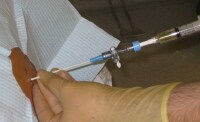Ischemic Heart Disease is the result of an imbalance between adequate oxygen supply to the myocardium and its' necessities, due to total or partial obstruction of the coronary arteries. Depending on the degree of coronary artery insufficiency and the rapidity of onset, ischemic heart disease might be acute or chronic. These include four anatomical and clinical entities :
* Chronic ischemic heart disease
o stabile angina pectoralis
* Acute ischemic heart disease
o unstabile angina pectoralis
o myocardium infarct
o sudden death
Etiology : coronary artery atherosclerosis (90 %), inflammation of coronary arteries (systemic lupus erythematosus, polyarteritis nodosa), tromboembolism (bacterial endocarditis), spasm, arrhythmia (e.g. : tachycardia in hyperthyroidism, anemia, intoxication, infections), syphilis.

Ischemic fibrosis of the myocardium (diffuse ventricular myocardial fibrosis) represents the morphological change in chronic ischemic heart disease. Clinically, may be silent or producing stabile angina pectoralis leading to congestive heart failure.
Pathology : during a diffuse coronary atherosclerosis, in which the stenosis is less than 70 % of the artery cross-section (this means, it is not enough to produce an infarct), some myocardial cells or small groups of cells, are inadequately supplied with blood (oxygen). These myocardial cells will become atrophic and necrotic. With time, the small areas of necrosis will be replaced by fibrosis.
At gross examination, the heart varies in size : normal, small (atrophic) or large (compensatory hypertrophy), dilated (in patients with congestive heart failure). Endocardium and pericardium are normal or with white plaques, corresponding to fibrosis. On section surface, the myocardium has a "tiger-spotted" aspect, due to intermingled normal myocardium (red) and fibrosis (ivory, white). Large areas of scarring might be visible if the patient had a previous infarct.
Microscopically, one can see small fibrous scars (with collagen fibers) surrounding viable myocardial cells (fibers), normal, with atrophy or with hypertrophy ("tiger-spotted" aspect). Also, might be present focal myocytolisis : isolated "empty" myocardial cells (no nuclei, no striations, eosinophilic cytoplasm) - ischemic necrosis.

Diffuse myocardial fibrosis (Ischemic fibrosis of the myocardium) (Simionescu trichromic staining, ob. x4) : myocardial cells (red) intermingled with collagen-rich fibrosis (blue) which completely replaced the necrotic myocardial cells. Capillaries (with yellow-orange red blood cells) within fibrosis remained from repair by connective tissue process.
Diffuse myocardial fibrosis (Ischemic fibrosis of the myocardium) (Simionescu trichromic staining, ob. x10) : viable myocardial cells (red) with nuclei (brown) surrounded by collagen-rich fibrosis (blue). Fibrosis completely replaced the necrotic myocardial cells. Capillaries (with yellow-orange red blood cells) within fibrosis remained from repair by connective tissue process.






































